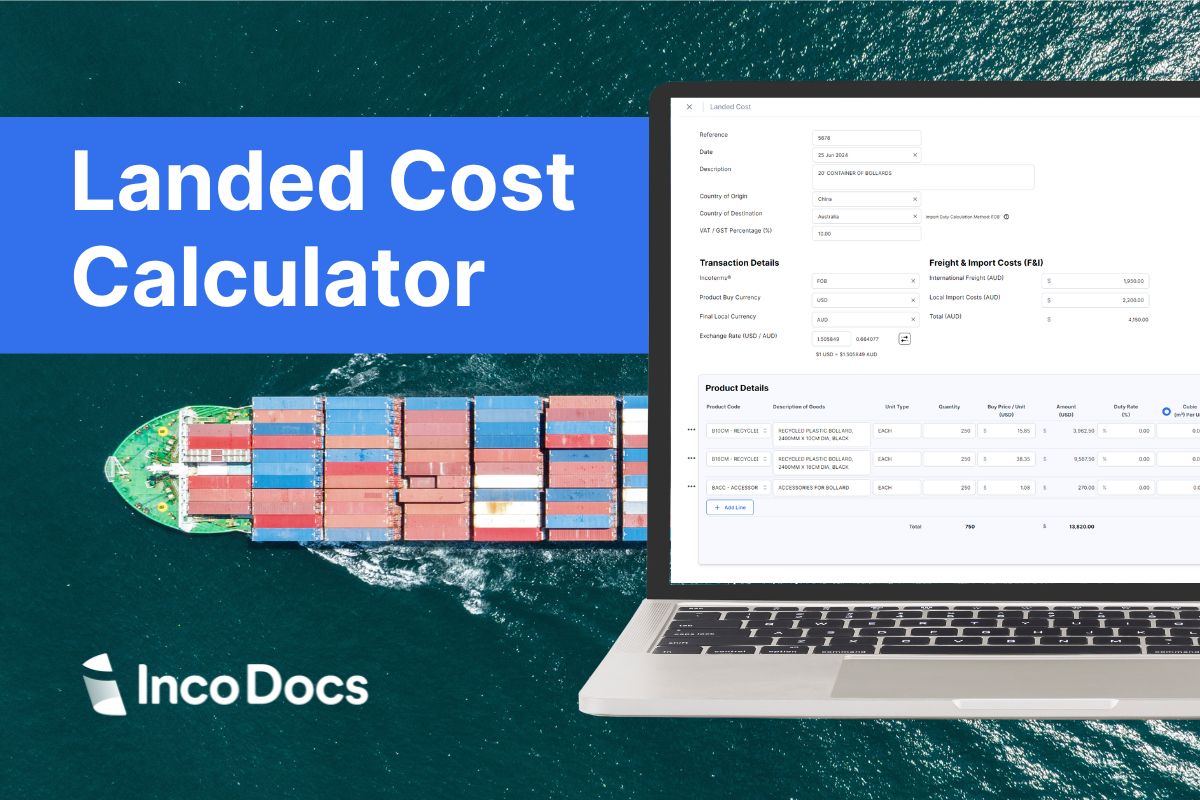Importers involved in global trade face numerous additional costs, fees, and charges when importing products to their final location, which can impact the average selling price. It’s imperative that buyers understand the actual final ‘landed cost’ and cost price of imported products in advance, to make smart decisions in their business.
In this article we provide a walkthrough on understanding the different components that make up landed costs. We also provide a step-by-step video guide on how to use the IncoDocs landed cost calculator to determine your landed costs, sell pricing and profit figures on imported products.
 Use the Landed Cost Calculator
Use the Landed Cost CalculatorUnderstanding the Components of a Landed Cost Calculator for Product Pricing
Before importers use a landed cost calculator, they should understand how to confirm all of the product and logistics costs involved to import the products through to their final location The various costs and details include:
- Supplier pricing and product details (Quotation or Proforma Invoice)
- All of the logistics and handling charges, including International shipping charges, local port fees, customs clearance fees and the applicable import duties & taxes
- Shipping methods, shipping container sizes and specifications
Understanding Supplier Pricing and Product Details
When Importers (buyers) source new products from Exporters (sellers), the exporter will communicate all of their product details, pricing and information.
It’s important for the buyer to get the seller to confirm all of the information required, to be able to complete the landed cost calculations. At times, communication between buyers and sellers can be difficult and getting all of the information included on to one document can be challenging.
Having all details confimed in writing is also helpful to avoid any disputes relating to product quality, specifications, pricing and delivery terms. The Quotation or Proforma Invoice document should include the following details:
- Seller & Buyer’s details (Shipper & Consignee).
- Incoterm® & Place (Refer Incoterms® 2020 chart in the Resources section).
- Port of Loading (POL) & Port of Discharge (POD).
- Product details – including product description, quantity, unit type, pricing and currency. The buyer may have to identify the applicable HS/HTS Code in the country of import).
- Packaging sizes & weights – Sellers may only provide the weight and sizes of the overall packaging. To work out accurate landed cost calculations, you should understand the size (cubic meter m3) and weight (kg) per unit.
- For example, a carton of 20pcs of widgets is 20kg and the carton size is 60cm x 40cm x 30cm (0.07m3). The cubic meter (m3) size is 0.0035m3 per unit, the weight is 1kg per unit.
- Shipment type, i.e. by Full Container – FCL, or Less-than-Container-Load LCL Cargo, Breakbulk etc and method of shipment by Sea, Air, Road or Rail. (Refer shipment types and container specifications chart further below)
- Lead Time – The time required to manufacture the products are have ready for delivery
- Payment Methods & Payment Terms – The agreed payment method and agreed payment terms (split deposit and balance payment details, if applicable)
- Bank Details – (for International **SWIFT TT payment)**
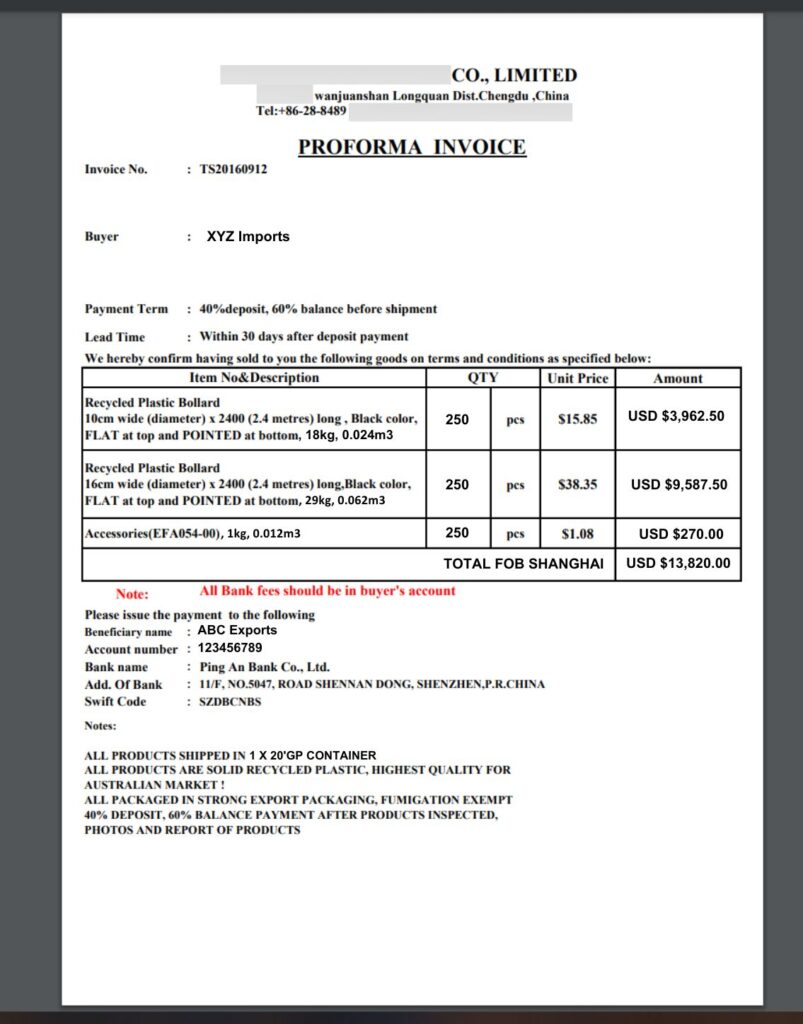
Understanding International Shipping Charges, Port Handling, Customs Clearance, Import Duties & Taxes
There are many different processes and costs involved along the global supply chain. One of the easiest ways to get confirmed costs is to deal with an experienced freight forwarding company.
Most global trade shipments are sold on the FOB Incoterm® (Free-On-Board) which means that the consignee (buyer) will pay for all additional costs and charges after the goods have been loaded on board the vessel for export.
A freight forwarder’s quote must be itemized to show all of the different fees and charges involved. These may include:
- International freight from Port of Loading to Port of Discharge (usually in USD). Note seafreight and airfreight rates vary throughout the year so you will have to confirm the validity dates of a forwarder’s quotation.
- Local charges in the country of import (get these costs in your local currency). These fees can include local port stevedorage/handling, documentation, customs clearance, quarantine, marine transit insurance and domestic trucking to deliver the shipment to the final location.
- Local Import Duty Rates. If you supply the HS Code for the goods to import, the freight forwarder or customs broker can confirm the applicable rate of import duty (%) that will be applied to the imported goods. The duty rate can be charged on FOB or CFR value, so ask the forwarder to confirm how these are charged in the country of import.
- Import Taxes. Understand the local percentage tax rate (VAT/GST) that is charged on imported goods and how it is applied to imported goods in the country of import.
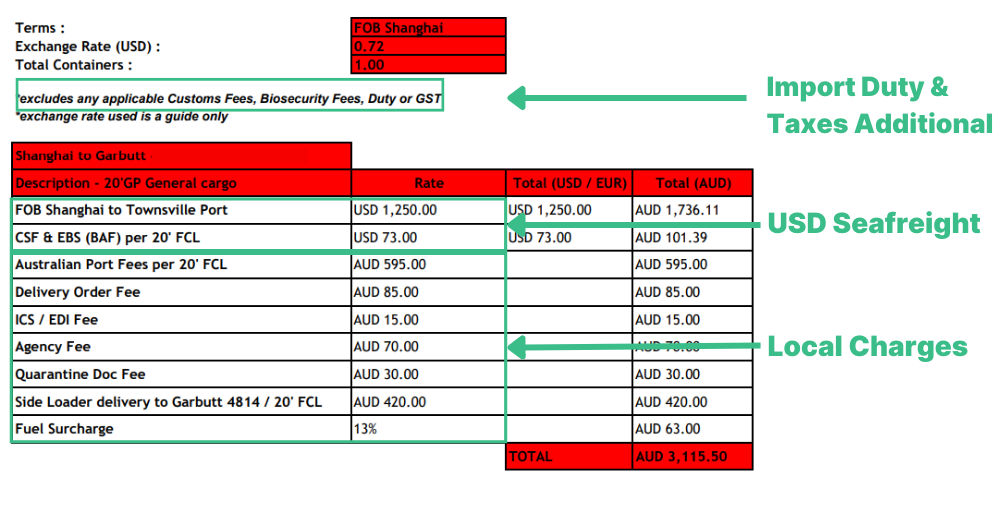
Understand Foreign Currency Exchange FX Rates and Fees
If you are purchasing goods in a foreign currency, you must understand the FX exchange rate that you can secure, and the payment processing fees involved to make FX payments. Remember that different foreign exchange providers will offer different rates.
You should also understand how a change in the FX rates will affect the cost of sending money to your supplier.
XE Exchange is a great resource to check the live FX trading rates. XE provide a free to use app that can be used to easily convert currencies at live rates. Download the app here.
Determine if freight is charged by Cubic (m3), or by Weight (Kg)
If importers are wanting to ship multiple items in 1 shipment, they will have to calculate the landed cost per unit. Importers can split up all of the additional transport/logistics/clearance costs by cubic volume (m3), or by weight (Kg), whatever is greater.
To do this, importers will need to calculate the cubic measurement (m3) per unit, or weight (kg) per unit. For example, if a sellers confirms that a carton of 20pcs of widgets is 20kg and the carton size is 60cm x 40cm x 30cm (0.07m3):
- The cubic meter (m3) size is 0.0035m3 per unit
- The weight is 1kg per unit
KG to Cubic Meter (M3) Conversions
Seafreight pricing will be charged by weight, or by cubic meter, whichever is greater
So 1000kg (or 1 Metric Tonne) is equivalent to 1CBM (m3). So, 1000 Kg = 1m3
Airfreight rates are charged differently to seafreight. For airfreight, the standard formula is:
Length x Width x Height (in Centimeters) divided by 6000 = Volumetric weight. 167 Kg = 1m3
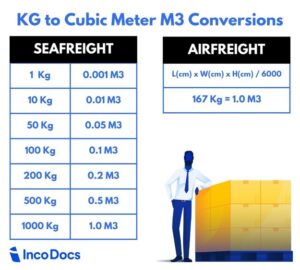
How many cubic meters of products will fit inside a shipping container?
Shipping containers obviously vary in size and therefore how many cubic meters of product will fit inside. The 20’ General Purpose GP shipping container is the most popular shipping container used, however they come in many different sizes and types (refer shipping container chart on the next page)
The chart below shows the internal and external dimensions of different types of shipping containers, and you can see the internal ‘capacity’ of each. Note that due to the way that goods are packaged, loaded and stacked inside shipping containers, it’s almost impossible to fill the containers to 100% capacity, as there will always be small space in between packages inside the container.
For example, the internal capacity of a 20’GP container is 33m3. However as a general rule, the practical loading capacity is a little more than 80% of the containers’ maximum capacity. In this case, a 20’ GP container should load a maximum of 28m3 of goods.
What is the maximum weight that can be loaded inside a shipping container?
The maximum weight is generally limited by the supply chain along which the container will be travelling. The container may travel by sea, road or rail, which will have their own maximum weight restrictions and limitations within different countries.
Although a 20’GP container can hold well over 20,000kg of product weight, you should consult a freight forwarder or logistics specialist to confirm the actual weight limitations for your specific shipments.

Step-by-Step Guide: Using the Landed Cost Calculator
 Use the Landed Cost Calculator
Use the Landed Cost CalculatorThe IncoDocs Landed Cost Calculator makes it quick and easy for importers to understand the landed cost and sell pricing of imported goods. It uses a complex selling price formula, that is more elaborate than other calculators.
Watch the step-by-step video guide using an example of a supplier’s proforma invoice for a 20’ container of bollards, shipped from China to Australia. Before using the landed cost calculator, make sure that you understand:
- The seller’s product details, pricing and packaging details
- International transportation costs and fees, based on the shipping method and Incoterm agreed
- The applicable import duty and tax rates in the country of import
Step 1. Entering Shipment, Product Details & Pricing
Shipment Details
At the top section of the calculator, enter all of the shipment details, transaction details and freight & import costs. The live exchange rate will automatically be provided.
Product Details
Here is where to enter all of the product details, line by line. You can also click to add and save your product codes, to pre-fill them next time.
The freight and import costs can be split over the different products based on each product’s ’cubic per unit’, or ’weight per unit’ options.
Click ’Calculate’ then the landed costs will show in the 2nd table below.
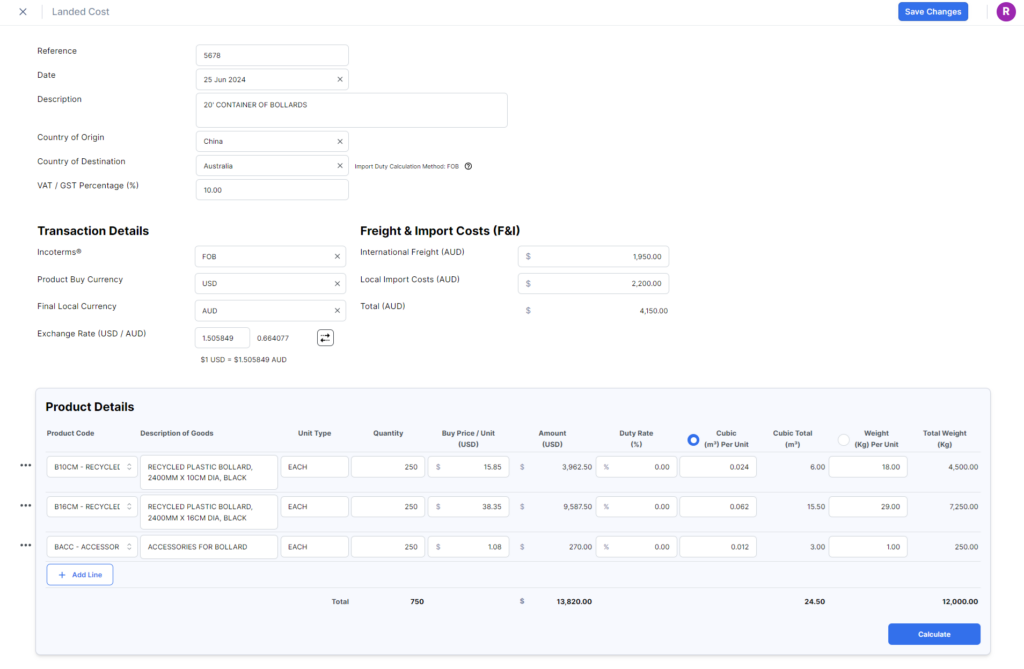
Step 2. Understanding the Landed Costs per product
The 2nd table will display the ‘Landed Cost (Ex. Tax)’, listed per product row. If importers are going to on-sell these products, they can move down to the 3rd table to calculate sell pricing and profit figures.

Step 3. Calculating Sell Pricing
The 3rd table is where importers can calculate sell pricing and profit figures. There are 3 options to set sell pricing:
- Click to enter a ‘Margin’ percentage for each product
- Click to enter a ‘Markup’ percentage for each product
- Click to type in a specific ‘Sell Price / Unit (Ex. Tax)’ for each product
This is very flexible and helpful for entering different margin or markup amounts to each product, allowing you to check the figures and decide how to price your product.
The left side shows the ‘Landed Cost (Ex. Tax)‘. The right side shows ‘Sell Price / Unit (Ex. Tax)’. Users can also understand the ‘Profit / Unit‘, and ‘Total Profit‘ figures per product type. The margin, markup or sell pricing can be changed at anytime, to allow importers to edit and view the live profit figures so they can make decisions on sell pricing.
Users can click to save their landed cost calculations as PDF files.
 Use the Landed Cost Calculator
Use the Landed Cost CalculatorPlacing New International Orders
Confirming Purchase Order & Proforma Invoice Agreements
When importers understand the landed cost of imported products, they can decide to place a new order with the supplier. Importers can place new orders with International suppliers by sending an official Purchase Order document.
Read more on how Purchase Order and Proforma Invoices work here.
Countersigning Proforma Invoice & Purchase Order Documents
Both the buyer and seller will have to countersign the Purchase Order and Proforma Invoice documents as they represent a legally binding agreement between the buyer and seller. If there are any disputes relating to the order or supply of goods, these documents will be referred to in a court of law.
Read how importers and exporters digitally countersign Proforma Invoices, Purchase Orders and other Sales Contracts.
The difference between a Proforma Invoice and a Commercial Invoice
A Proforma Invoice is an invoice issued pre-shipment, to confirm new orders and request payment. A Commercial Invoice format is essentially the same as a proforma invoice, but the Commercial Invoice is issued to the buyer after the goods have been delivered or shipped, and confirms the exact quantity of the products that have actually been loaded and shipped. The Commercial Invoice will also include the shipment’s vessel and voyage details.
Landed Cost Calculations Resources & Tools
Below are some additional resources that will help to calculate the landed costs for imported products:
PDF Charts:
Online Tools:
Purchase Orders and Proforma Invoices:
